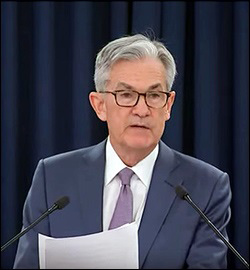By Pam Martens and Russ Martens: December 9, 2020 ~
The U.S. Senate Banking Committee, the House Financial Services Committee, and the U.S. mainstream business media now thoroughly qualify as the dumb tourists snapping photos of the raging bull statue on Wall Street as the Wall Street banks loot the country for the second time in a decade.
Last Thursday the Financial Stability Oversight Council (pronounced F-SOC) released its 2020 Annual Report. Those tend to be tediously boring reports that tell one nothing meaningful about the true state of the Wall Street mega banks, so we just got around to perusing the document yesterday. Mixed in with the typical snooze-worthy minutiae was a bombshell that made us sit up straight in our chair. Those cumulative repo loans totaling more than $9 trillion to the trading houses on Wall Street that the Fed had been making from September 17 of 2019 – months before the onset of COVID-19 anywhere in the world – didn’t actually stop in July as the daily data from the Fed made it seem. The New York Fed simply went dark and stopped reporting how many billions of dollars a week it was funneling to miscreant mega banks on Wall Street as food pantry lines grew by miles across the U.S. and 3.3 million small businesses were forced to shutter.
F-SOC was created as an agency under the Treasury Department when the toothless Dodd-Frank financial reform legislation was passed in 2010. Each major federal regulator of banks sits on F-SOC with the Treasury Secretary acting as the permanent Chair. F-SOC defines its mission as follows: “The Council is charged with identifying risks to the financial stability of the United States; promoting market discipline; and responding to emerging risks to the stability of the United States’ financial system.”
As for F-SOC “promoting market discipline” – this is the second time in a decade that the Federal Reserve has pumped trillions of dollars into the Wall Street mega banks without any oversight from Congress. The last time around, from 2007 to 2010, the Fed secretly pumped $29 trillion in cumulative loans to bail out the hubris of Wall Street’s obscenely paid CEOs and traders. (The audit of the Fed’s secret loans by the Government Accountability Office (GAO) reported $16.1 trillion, but it omitted several Fed bailout programs.)
Before the Fed went dark this time around on its repo loans, we had tallied up more than $9 trillion in cumulative loans by March of this year. The New York Fed was reporting these repo loans daily on a page of its website from September 2019 through early July of this year. Then it began to report zeros on a daily basis for the amount of the repo loans, giving the obvious impression to reporters and market watchers that the markets had stabilized and the banks were in fine shape.
Now we find out from F-SOC’s Annual Report that these repo loans never did stop. The smoking gun paragraph reads as follows:
“Primary dealer cash borrowing in the repo market, including borrowing from FRBNY’s temporary open market operations, stood at $2.5 trillion as of September 30, 2020….”
FRBNY stands for the Federal Reserve Bank of New York, the regional Fed bank that initiated the repo loans to Wall Street’s trading houses on September 17, 2019 and reported them daily through June until the designated page on its website began to report zeros for loans being requested by the trading houses (primary dealers) and accepted by the New York Fed.
This impression of calm also gave confidence to the stock market, which proceeded to set record highs, blissfully unaware (along with Congress and the mainstream business media) that the New York Fed continued to feed the Wall Street beast untold amounts of super cheap money created electronically out of thin air at the Fed.
If the Fed had wanted the public to clearly understand that its repo loans were ongoing but had simply gone dark, it could have printed a statement to that effect on the daily page it posted showing zeros going out in repo loans. After reading the F-SOC revelation, we searched the New York Fed’s website for hours to see if it had ever made a public statement that it was going dark on the dollar amounts of its repo loans. We finally found this statement dated June 11, 2020:
“Beginning with this month’s release, the Desk will no longer publish daily updates with the next business day’s operational details.”
That is about as clear as mud in terms of indicating that the Fed will no longer reveal how much it is making in loans to Wall Street’s trading houses.
Wall Street On Parade suspected that the Fed was secretly pumping out huge sums to Wall Street and that this information would be revealed some day, just as the $29 trillion was revealed in 2011. Thus, we archived the more than 100 articles we had written on this latest era of Fed bailouts and its failure to come clean with Congress and the American people. You can peruse that archive here and we’ve selected some of the key related articles below.
Perhaps it was the article we wrote on June 9 that made the Fed go dark on its repo loan bailouts. See Fed’s Repo Loans to Wall Street Skyrocket by 230 Percent Week Over Week.
Related Articles:
Wall Street’s Financial Crisis Preceded COVID-19: Chart and Timeline
These Are the Banks that Own the New York Fed and Its Money Button
Five Mega Wall Street Bank Stocks Have Lost Average of 45 Percent in Five Weeks
The Fed Has Secreted Away the Transactions of Three of Its Emergency Lending Programs


